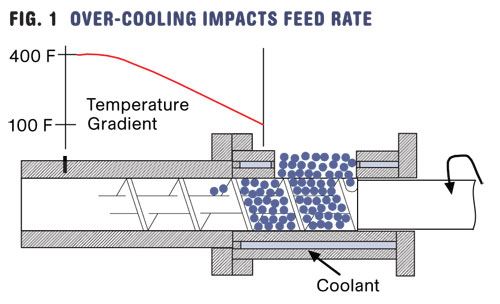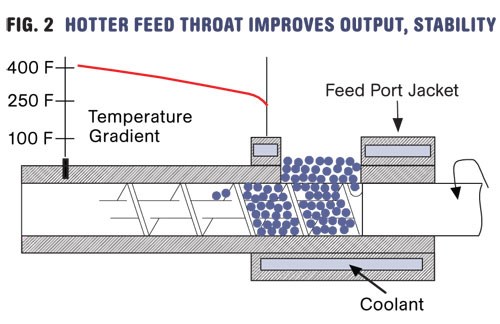Extrusion: Don’t Forget Zone ‘Zero’
Have you ever heard of zone zero?
Have you ever heard of zone zero? Do you know where it is? Well, it’s the feed throat. It’s the zone most extruder manufacturers do not treat as a barrel zone. But nothing goes through the extruder that doesn’t go through the feed throat first. Feed throat design and temperature control can have a lot to do with extruder output and energy efficiency.
In an earlier column I discussed feed throat design and how it can affect extruder performance. Now, let’s focus on the thermal aspects. The same solids-feeding principles that occur in the barrel immediately past the feed throat apply to the feed throat itself. That is, the polymer must stick to the barrel more than it does to the screw to move forward. The most effective thing for improving polymer-to-barrel friction is to get heat into the barrel wall. As I said, everything that goes through the extruder goes through the feed throat first, so this can be a controlling aspect of the process.
As a processor, the only way you can maximize feed-throat performance is to adjust its temperature. That is not as easy as it sounds, because the only control typically supplied by the machine builder is a coolant flow valve, and often that valve is not designed for accurate flow control. Moreover, the coolant temperature and flow rate often change during the day as the demand or temperature changes inside or even outside the plant. Consequently the feed throat can change temperature with no adjustment by the operator.
You can solve this problem by adding a modulating valve as a flow control, which can be a controlled by a thermocouple attached to the feed throat. This does not optimize feed throat performance but does keep it at a fixed point.
Have your operators ever had a case where some polymer had melted in the feed throat during a prolonged screw stoppage while the barrel heaters were left at operating temperatures? Not wanting that to ever happen again, most operators run full coolant flow to the feed throat. They are not considering the feed throat as part of the process, but rather as a disconnected apparatus that has nothing to do with the process.
Nothing could be further from the truth. Not only is the feed rate established in the feed throat, but over-cooling the feed throat can extract as much as 20% of the total drive power by pulling heat constantly from zone 1. As you can see from Fig.1, the feed throat has a metal-to-metal connection that is very effective at transferring heat. Since the first zone thermocouple is some distance down the barrel from the feed throat, a gradient is developed between the zone 1 setting and the feed throat. That gradient further affects the feed rate by cooling the barrel in the location where it’s critical to develop solids feeding, solids-bed compaction, and heat to initiate melting.
The point is further illustrated by the performance of extruders that do not use a separate feed throat—i.e., the barrel extends through a feed-port jacket. Such a design is shown in Fig. 2. The temperature at the barrel inner wall is maintained at a much higher level, as the thermal conductivity through the barrel is much higher than the conductivity from the barrel to the jacket and then to the coolant. As a result, the inner barrel wall is much hotter at the feed opening. In tests, this has accounted for as much as 23% increased output with the same screw. The main disadvantage to the jacket design is that the polymer can melt in the feed opening and on the screw much quicker, requiring more operator attention when the screw is stopped. However it shows the positive effect on output of a hotter feed throat. I have also found that extruders with this design generally have more stable output.
For most polymers, I like to start with a feed throat that is hot to the touch (110 to 120 F), and gradually reduce the coolant flow, thereby increasing the feed throat temperature until I see no increase in output. This takes a while, as the feed throat is slow to change temperature because of its mass and the transfer of heat to the gearbox, hopper, and resin. Each polymer, extruder, and operating condition will require a slightly different throat temperature to optimize output—but hotter is usually better.
About the Author
Jim Frankland is a mechanical engineer who has been involved in all types of extrusion processing for more than 40 years. He is now president of Frankland Plastics Consulting, LLC. Contact jim.frankland@comcast.net or (724)651-9196.
Related Content
The Effects of Stress on Polymers
Previously we have discussed the effects of temperature and time on the long-term behavior of polymers. Now let's take a look at stress.
Read MoreBack to Basics on Mold Venting (Part 1)
Here’s what you need to know to improve the quality of your parts and to protect your molds.
Read MoreHow to Select the Right Tool Steel for Mold Cavities
With cavity steel or alloy selection there are many variables that can dictate the best option.
Read MoreThe Effects of Time on Polymers
Last month we briefly discussed the influence of temperature on the mechanical properties of polymers and reviewed some of the structural considerations that govern these effects.
Read MoreRead Next
Making the Circular Economy a Reality
Driven by brand owner demands and new worldwide legislation, the entire supply chain is working toward the shift to circularity, with some evidence the circular economy has already begun.
Read MoreSee Recyclers Close the Loop on Trade Show Production Scrap at NPE2024
A collaboration between show organizer PLASTICS, recycler CPR and size reduction experts WEIMA and Conair recovered and recycled all production scrap at NPE2024.
Read MoreBeyond Prototypes: 8 Ways the Plastics Industry Is Using 3D Printing
Plastics processors are finding applications for 3D printing around the plant and across the supply chain. Here are 8 examples to look for at NPE2024.
Read More
.jpg;width=70;height=70;mode=crop)























